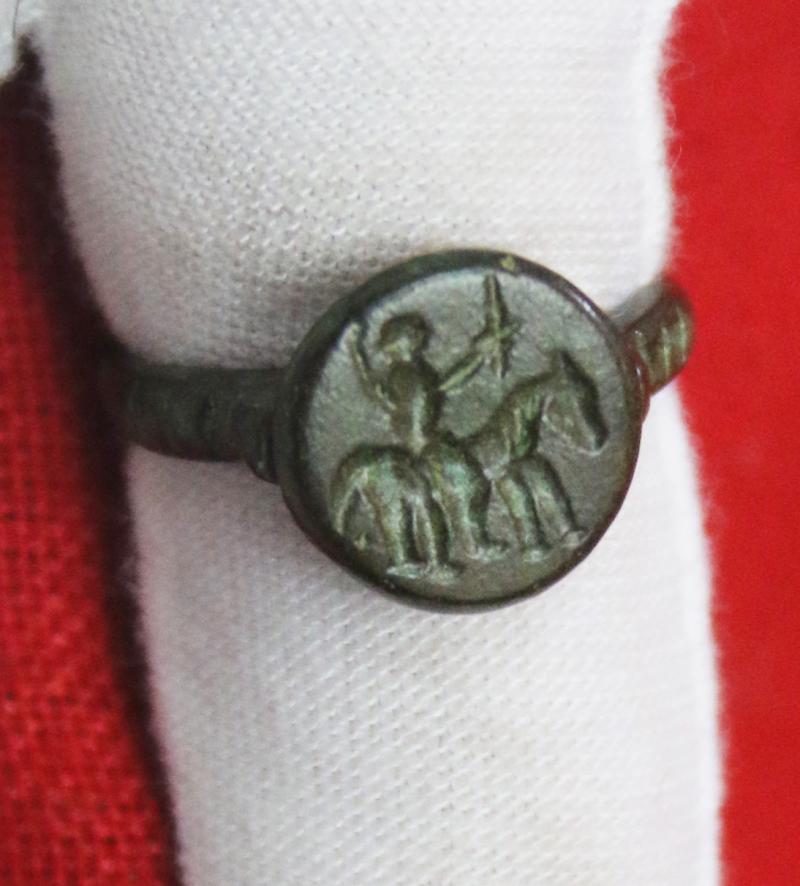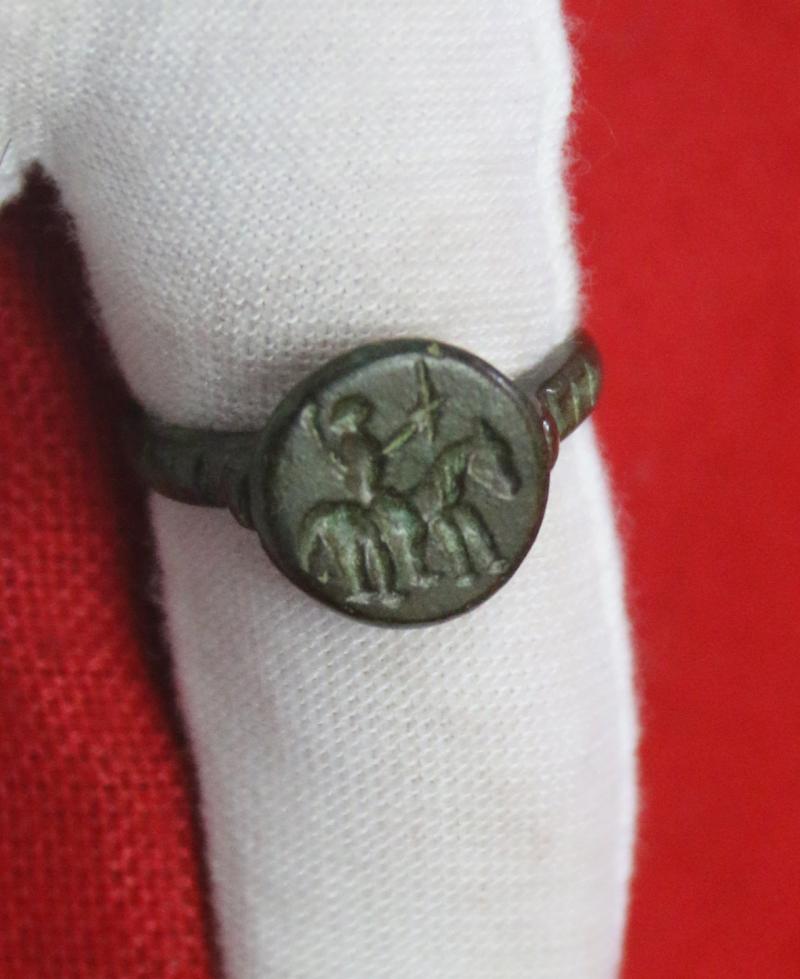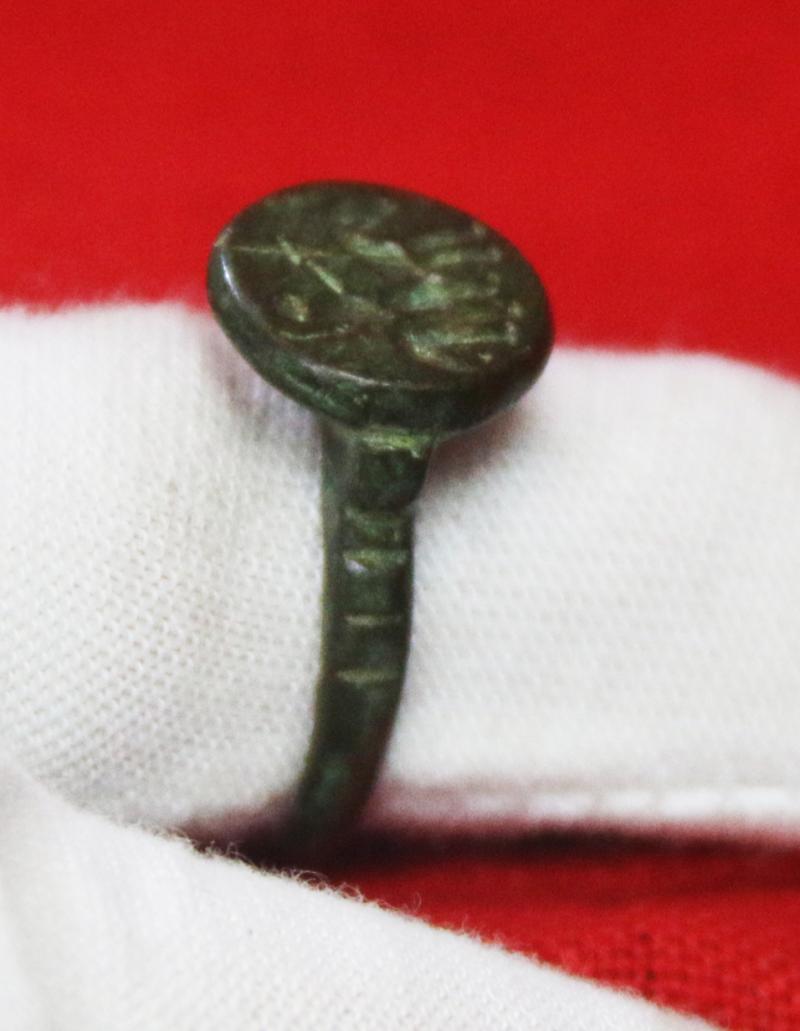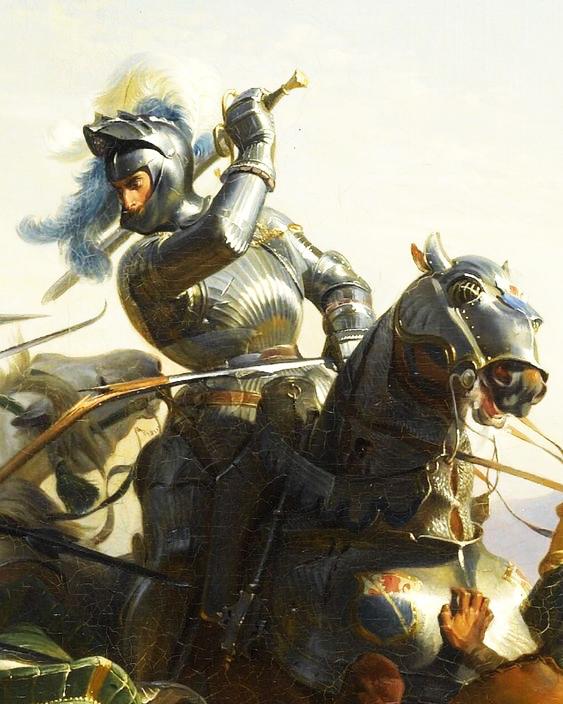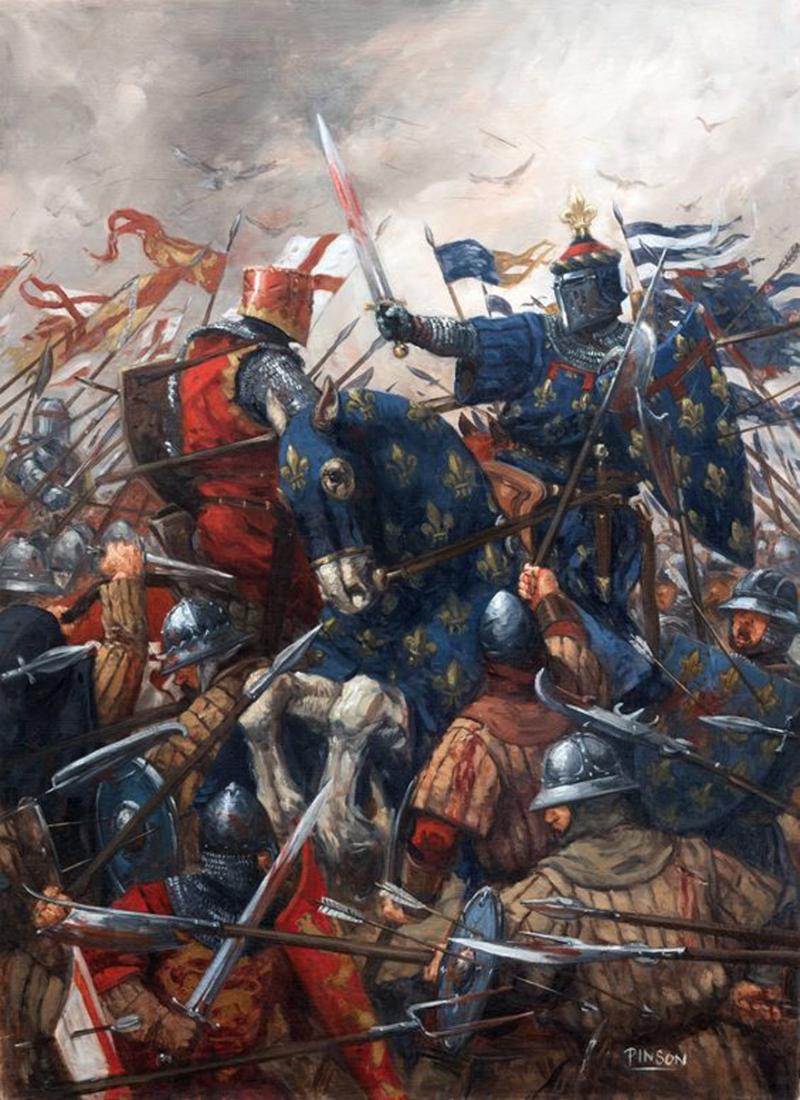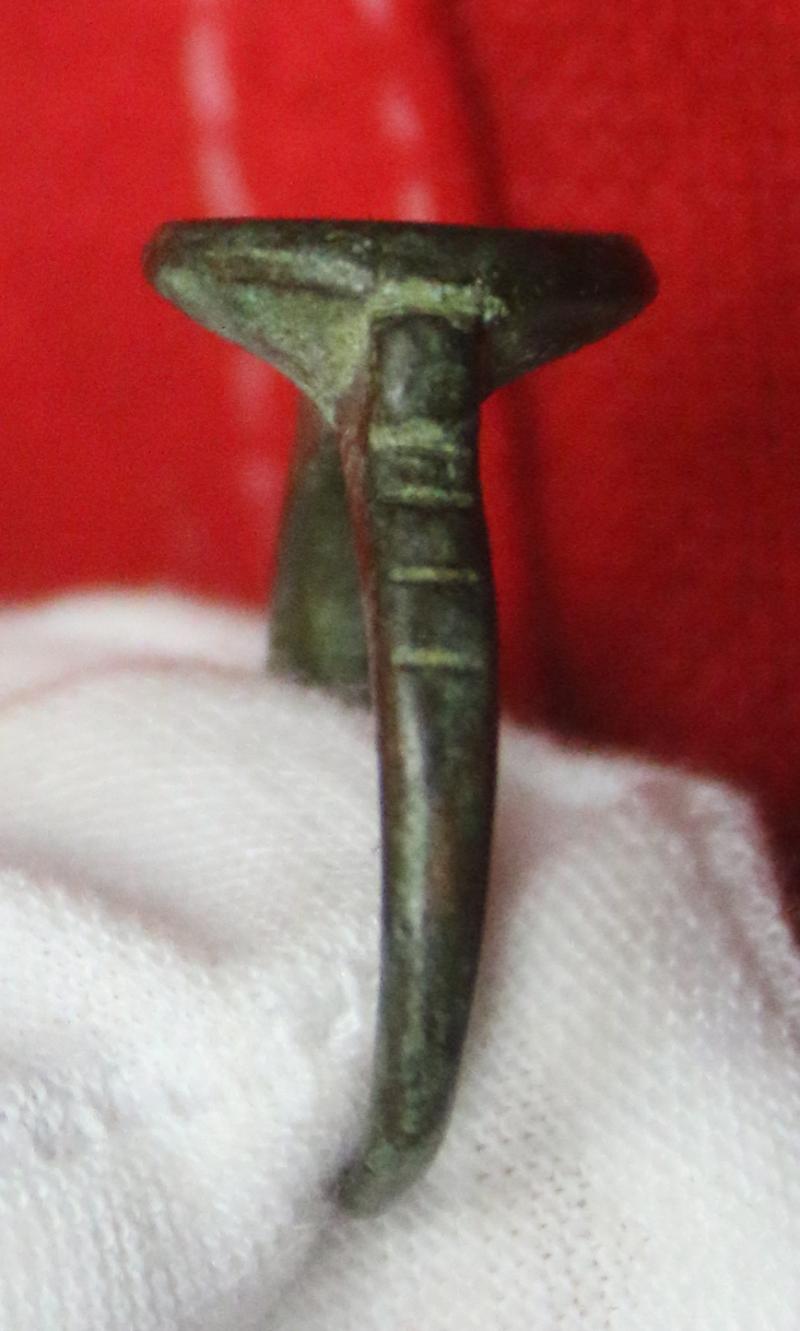A Fabulous Knight’s Seal Ring, From Agincourt to the Wars of the Roses Period. A 15th Century Ring with an Intaglio Stylized Engraving of An Armoured Knight on Horseback Holding Aloft His Knightly Sword, a Fabulous and Beautiful Piece.
This is a really rare original piece, and it has been many decades since we last even saw an intaglio seal ring, made for a knight of the realm, that is actually depicting an engraved armoured knight as the body of the seal itself, but as one that is holding his sword aloft for combat, this must be the rarest of all.
Overall it is in fabulous condition with a stunning naturally aged bronze patination. Around 600 years old probably worn for a 100 years, or possibly much more. The intaglio seal engraving is superb. Armour-protected knights charged on horseback wielding their knightly swords and lances ten to eleven feet long (cut down to as short as five feet by both the French and English at the Battle of Agincourt). The age of the lance ended with the rise of the bowmen in the fourteenth century. While the devastating volleys of English longbow men had initiated the change at Crecy on August 26, 1346, it was massed bodies of pikemen that really thwarted cavalry charges, as they did at the Battle of Pavia in 1525. Large quantities of lances would also have been used at Agincourt by men-at-arms, the sword by knights and some men-at-arms. The small mounted French force at the battle tasked with driving off the English archers would have been equipped with this lance type weapon. The vast majority of the French men-at-arms, and all of the English, were dismounted but still used lances at Agincourt. The English had an advantage over the French at the battle however, because the latter had decided to shorten their lances to give them greater control over their weapons prior to the battle. This proved to be a mistake during the melee as the longer English lances meant that they had a greater reach and were able to push over the French. One account of the lance used at Agincourt involved an assault on King Henry himself." under the banner of the Lord of Croy, eighteen gentlemen banded themselves together of their own choice, and swore that when the two parties should come to meet they would strive with all their might to get so near the King of England that they would beat down the crown from his head, or they would die, as they did; but before this they got so near the said King that one of them with the lance which he held struck him such a blow on his helmet that he knocked off one of the ornaments of his crown. But not long afterwards it only remained that the eighteen gentlemen were all dead and cut to pieces; which was a great pity; for if every one of the French had been willing thus to exert himself, it is to be believed that their affairs would have gone better on this day. And the leaders of these gentlemen were Louvelet de Massinguehem and Garnot de Bornouille" King Henry V of England led his troops into battle and participated in hand-to-hand fighting, sword in hand. The French king of the time, Charles VI, did not command the French army himself, as he suffered from severe psychotic illnesses with moderate mental incapacitation. Instead, the French were commanded by Constable Charles d'Albret and various prominent French noblemen of the Armagnac party.
This battle is notable for the use of the English longbow in very large numbers, with the English and Welsh archers forming up to 80 percent of Henry's army. The decimation of the French cavalry at their hands is regarded as an indicator of the decline of cavalry and the beginning of the dominance of ranged weapons on the battlefield.
Agincourt is one of England's most celebrated victories. The battle is the centrepiece of the play Henry V by Shakespeare. Juliet Barker in her book Agincourt: The King, the Campaign, the Battle ( published in 2005) argues the English and Welsh were outnumbered "at least four to one and possibly as much as six to one". She suggests figures of about 6,000 for the English and 36,000 for the French, based on the Gesta Henrici's figures of 5,000 archers and 900 men-at-arms for the English, and Jean de Wavrin's statement "that the French were six times more numerous than the English". The 2009 Encyclopeadia Britannica uses the figures of about 6,000 for the English and 20,000 to 30,000 for the French.
The Wars of the Roses were a series of dynastic wars for the throne of England. They were fought between supporters of two rival branches of the royal House of Plantagenet, the Houses of Lancaster and York. They were fought in several sporadic episodes between 1455 and 1487, although there was related fighting before and after this period. The conflict resulted from social and financial troubles that followed the Hundred Years' War, combined with the mental infirmity and weak rule of Henry VI, which revived interest in the alternative claim to the throne of Richard, Duke of York.
The final victory went to a claimant of the Lancastrian party, Henry Tudor, who defeated the last Yorkist king, Richard III, at the Battle of Bosworth Field. After assuming the throne as Henry VII, he married Elizabeth of York, the eldest daughter and heiress of Edward IV, thereby uniting the two claims. The House of Tudor ruled England and Wales until 1603. Queen Margaret and her son had fled to north Wales, parts of which were still in Lancastrian hands. They later travelled by sea to Scotland to negotiate for Scottish assistance. Mary of Gueldres, Queen Consort to James II of Scotland, agreed to give Margaret an army on condition that she cede the town of Berwick to Scotland and Mary's daughter be betrothed to Prince Edward. Margaret agreed, although she had no funds to pay her army and could only promise booty from the riches of southern England, as long as no looting took place north of the River Trent.
The Duke of York left London later that year with the Earl of Salisbury to consolidate his position in the north against the Lancastrians who were reported to be massing near the city of York. He took up a defensive position at Sandal Castle near Wakefield over Christmas 1460. Then on 30 December, his forces left the castle and attacked the Lancastrians in the open, although outnumbered. The ensuing Battle of Wakefield was a complete Lancastrian victory. Richard of York was slain in the battle, and both Salisbury and York's 17-year-old second son, Edmund, Earl of Rutland, were captured and executed. Margaret ordered the heads of all three placed on the gates of York.
A fine, ancient, but even wearable ring size N1/2
Code: 25457
1495.00 GBP


